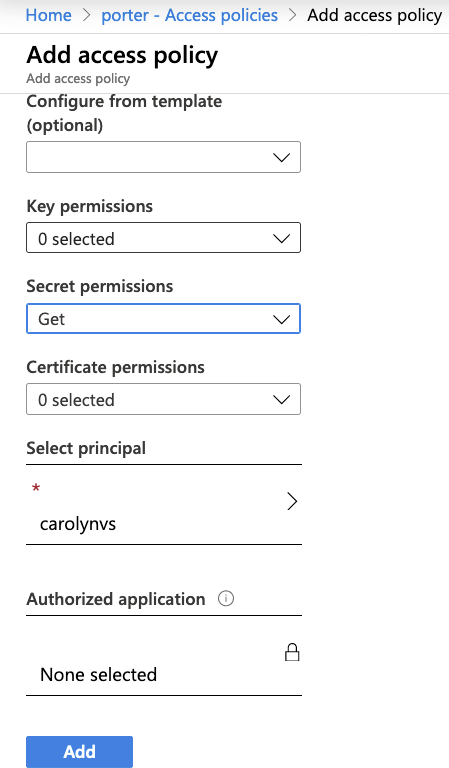Working with Plugins
In this tutorial we will use the Azure plugin to demonstrate how to configure and use plugins with Porter. This allows us to manage bundles as a team and resolve credentials from a secure secret store.
- Prerequisites
- Create a key vault
- Add a secret
- Create a service principal
- Configure permissions on key vault
- Configure Porter to use the plugin
- Try it out
Prerequisites
- A Microsoft Azure account
- Install Porter
Create a key vault
-
From the Azure portal menu, select Create a resource. In the Search box, type Key Vault.
-
On the Key Vault section, choose Create.
-
For the tutorial we recommend using the same subscription, resource group and location that you used for the storage account.
-
Click Create.
Add a secret
The bundle used in this tutorial retrieves a secret named “password” stored in this key vault.
-
Navigate to your new key vault in the Azure portal.
-
In the left menu for the storage account, scroll to the Settings section and then select Secrets.
-
Select the + Generate/Import button.
-
Set the Name of the secret to
password. -
Set the Value of the secret to any value, for example
TopSecret!. The value itself is not important for this tutorial, only that a value is set. -
Leave the other fields with their default values.
-
Click Create.
Create a service principal
Now we will create a service principal and give it access to our key vault.
-
From the Azure portal menu, select Create a resource. In the Search box, type Azure Active Directory.
-
Next select App registrations, then + New registration.
-
Name your application porter-plugin-tutorial.
-
Leave the other fields with their default values.
-
Click Register.
-
On the app registration page, note the Application (client) ID and Directory (tenant) ID, and then define environment variables for them:
bash
export AZURE_CLIENT_ID="<APPLICATION_CLIENT_ID>" export AZURE_TENANT_ID="<DIRECTORY_TENANT_ID>"powershell
$env:AZURE_CLIENT_ID="<APPLICATION_CLIENT_ID>" $env:AZURE_TENANT_ID="<DIRECTORY_TENANT_ID>" -
In the left menu for the app registration, scroll to the Manage section and select Certificates & secrets.
-
Under Client secrets click + New client secret.
-
Leave the fields with their default values.
-
Click Add.
-
Copy the generated client secret and define an environment variable for it:
bash
export AZURE_CLIENT_SECRET="<CLIENT_SECRET>"powershell
$env:AZURE_CLIENT_SECRET="<CLIENT_SECRET>"
Configure permissions on key vault

-
Navigate to your new key vault in the Azure portal.
-
In the Settings section of the key vault overview, select Access policies.
-
Click + Add Access Policy.
-
In the Secret Permissions field select Get.
-
In the Select principal field, select the service principal created in the previous section.
-
Leave the other fields with their default values.
-
Click Add.
Configure Porter to use the plugin
Now that we have all the data the plugin would need to connect to our cloud resources, the last step is to update Porter’s configuration, so it uses the plugin.
-
Open or create
~/.porter/config.yaml. -
Add the following lines to activate and configure the Azure keyvault secrets plugin. Replace
myvaultwith the name of the Key Vault that you created earlier.default-secrets: "mysecrets" secrets: name: "mysecrets" plugin: "azure.keyvault" config: vault: "myvault"
Try it out
Let’s try out Porter with the plugin activated and see it in action!
$ porter list
NAME CREATED MODIFIED LAST ACTION LAST STATUS
We will use the ghcr.io/getporter/examples/plugins-tutorial:v0.2.0 bundle, let’s use porter explain to see what credentials are necessary.
$ porter explain ghcr.io/getporter/examples/plugins-tutorial:v0.2.0
Name: plugins-tutorial
Description: Example of porter resolving credentials from a secrets store using a plugin.
This bundle is a companion for the plugin tutorial at https://porter.sh/plugins/tutorial/.
Version: 0.1.0
Credentials:
Name Description Required
password Password for installing the world. We recommend getting this from a secret store. true
Since the bundle needs a credential, let’s generate it using porter credentials command.
First, run porter credentials create <file-name> to generate the template file.
Then, edit the file to include required credentials and set the source for its value.
Lastly, run porter credentials apply <file-name> to generate the credential set.
$ porter credentials create plugins-tutorial.json
creating porter credential set in the current directory
$ cat plugins-tutorial.json
# modify plugins-tutorial.json with your editor to the content below
{
"schemaType": "CredentialSet",
"schemaVersion": "1.0.1",
"name": "plugins-tutorial",
"credentials": [
{
"name": "password",
"source": {
"secret": "password"
}
}
]
}
$ porter credentials apply plugins-tutorial.json
Applied /plugins-tutorial credential set
For more information on how to use porter credentials commands, take a look at our credentials quickstart guide.
Now we are ready to install the bundle and pass it our generated credentials. 🎉 Porter is using the Azure plugin to inject the password credential from Azure Key Vault into the bundle during install.
$ porter install --reference ghcr.io/getporter/examples/plugins-tutorial:v0.2.0 -c plugins-tutorial
installing plugins-tutorial...
executing install action from plugins-tutorial (installation: plugins-tutorial)
Install World
Using Magic Password: *******
execution completed successfully!
$ porter list
NAME CREATED MODIFIED LAST ACTION LAST STATUS
plugins-tutorial 51 seconds ago 49 seconds ago install success